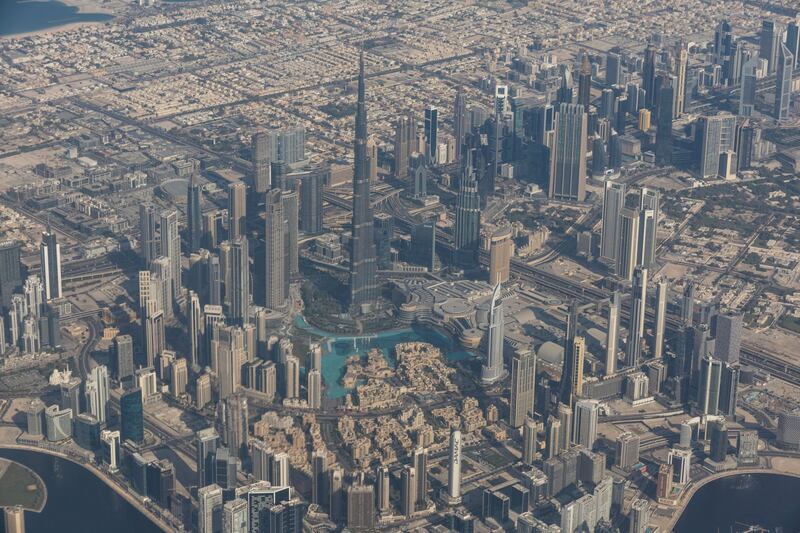A steep rise in oil revenue is set to drive up the aggregate external assets of oil-rich Gulf states to as much as $6 trillion if crude prices remain buoyant, according to Goldman Sachs estimates.
The upside scenario of $6 trillion could be reached if oil prices average $120 a barrel until the end of 2026, the US investment bank said in its Mena 2023 Outlook report this week.
“In our base case, which sees Brent crude averaging $83 per barrel over the next five years, we estimate that GCC external assets could reach $5.5 trillion by end-2026, an increase of $1.3 trillion over the next four years,” said Farouk Soussa, Mena economist at Goldman Sachs.
In a downside scenario, where oil prices decline to $40 per barrel, “GCC assets could plateau at just under $5 trillion”.
“Our projections are highly dependent on the assumed trajectory of oil prices,” Mr Soussa said.
The price of Brent, the global benchmark for two thirds of the world’s oil, rose to a notch under $140 a barrel in March after Russia’s military assault on Ukraine, but gave up most gains in recent months.
Oil prices have dropped to near $80 a barrel from their June peak of about $129 a barrel amid weakening economic outlook and demand concerns.
Brent was trading down 0.2 per cent at $80.52 at 7.49am UAE time on Wednesday. West Texas Intermediate, the gauge that tracks US crude, was 0.16 per cent lower at $75.27 a barrel.
Even with recent softness, oil prices remain well in excess of the GCC's fiscal and breakeven levels of about $65 and $50 a barrel, respectively, according to Goldman Sachs' estimates.
“Should oil prices rise in line with our relatively bullish medium-term forecasts, hydrocarbon revenues for GCC oil would rise to levels close to the historic high achieved in 2012,” Mr Soussa said.
“Combined with historically low fiscal and external break-evens, this implies significant fiscal and external surpluses over the coming five years.”
Economies in the GCC bounced back strongly after the coronavirus-driven slowdown last year and the growth momentum has picked up further pace this year, driven by higher oil revenue.
Swift action to mitigate the effects of the pandemic have also boosted GCC economies, which are set to double their growth this year despite geopolitical and macroeconomic headwinds, according to an International Monetary Fund staff report earlier this month.
The fund expects the oil-rich economies of the GCC to grow by 6.5 per cent this year, up from 3.1 per cent in 2021. The growth — led by Saudi Arabia and the UAE, the two biggest Arab economies — is expected to moderate to 3.6 per cent next year.
The World Bank has forecast that Gulf economies will grow 6.9 per cent this year before decelerating to 3.7 per cent and 2.4 per cent in 2023 and 2024, respectively.
The total economic output of the countries in the six-member bloc is expected to hit $2 trillion in 2022, the IMF said in its Gulf Economic Outlook in October.
If the Gulf countries continue business as usual, the region’s combined GDP will grow to $6 trillion by 2050, the World Bank report said.
That figure could shoot up to more than $13 trillion by 2050 if they adopt a strategy of green growth that speeds up economic diversification.
Goldman Sachs remains bullish on the oil sector and economic prospects of the GCC for the medium to long term.
It said the recent softness in oil markets should be viewed in perspective as oil prices are still high relative to their average over the past several years.
“They would need to remain significantly lower for longer before we turned bearish on [a] GCC macro [economic scenario],” the report said.
Goldman Sachs expects the oil windfall will lead to a significant pick-up in domestic investment, driving stronger economic growth.
“This is particularly true in Saudi Arabia, where the list of mega-projects currently under way implies over $700 billion in domestic investment between now and the end of the decade,” Mr Soussa said.
The strength of economic fundamentals is also supportive for GCC risk assets in the medium term, according to the bank.
“Twin surpluses are driving outperformance of regional credit, according to our EM [emerging markets] credit strategists, who highlight the attractiveness of high-yield oil producers [Oman and Bahrain] in particular,” Mr Soussa said.
“Our equity research colleagues are also bullish on regional equity markets, which are seeing a rapid expansion thanks to new listings, as well as higher valuations.”







